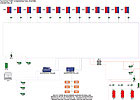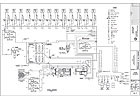
Figure 1. A schematic of the chiller system at the Taco plant.
(Figure courtesy of Taco.)
Back in the early 1900s, life was simpler, and environment and energy conservation issues were not a major concern in America. We wouldn’t say the environment was cleaner back then when you look at early photographs of factory smoke stacks, but energy usage was limited, with no demand for 24/7 consumption of electricity and fossil fuels. As America progressed through the Industrial Age, we either tore down the buildings of the past or left them in a state of deterioration. Even back then, we were a “throw away” society with no clear vision or interest in what America would look like in another century.
Well, 100 years have passed, and we are now realizing the serious state of our environment. Taco, Inc., headquartered in Cranston, RI, is one of the many companies now doing something positive for the environment, as well as for their community. But for John Hazen White Jr., president and owner of Taco, Inc., concern for the environment is not a recent fad; sensitivity toward the environment, energy, and the community has been part of the company philosophy for its nearly 100-yr history.
Elwood White established Taco (Thermal Appliance Company) in 1920 with a vision as to how a little domestic water heater business could succeed. His son, John Hazen White, Sr., continued this vision and expanded it after his father’s death with a focus on controlling heating system/energy performance through the development of hydronic-based components for use in the heating and cooling application for residential, commercial, and industrial application.
As the company grew, Taco moved from its Providence, RI manufacturing site to neighboring Cranston in 1954 where an abandoned turn-of-the-century trolley maintenance facility would accommodate the company’s growth in manufacturing without abandoning the community for a warmer, less expensive location.
Today, with our current focus on energy conservation and reuse of existing materials (including the reuse of existing buildings), we are only now realizing what Taco, Inc. recognized back in 1954. This reinvesting in the past with an eye toward the future has saved many early 20th century facilities. Without this new attitude, buildings like the Cranston trolley maintenance structure would probably be gone from the landscape and in their place would be mini-malls and large commercial buildings.
In 2007, with continued growth and an ongoing emphasis on the environment, energy conservation, and the community, Taco celebrated the grand opening of the 60,000-sq-ft building addition to the old trolley maintenance building-turned manufacturing facility. White, Jr. dedicated the building to his parents, John Sr. and Happy White, and in the spirit of preserving the environment and saving energy, this new addition is pursuing LEED® New Construction (NC) certification. The project consists of a single-story warehouse addition that provides 12 loading dock bays, 30-ft high clearance for storage racking systems, a print shop, administrative office space, a demonstration mechanical room for the radiant snow-melt system, and facilities for the manufacturing plant’s coolant and metal chip recycling systems.
Taco determined that an addition to their existing Cranston manufacturing facility was needed to accommodate their business plan as well as their community investment philosophy. Long before sustainability became a popular word, Taco determined that this project would make an energy efficiency and environmental statement of how sustainability should include building reuse and community investment. And so LEED NC became the foundation of the building program.
LEED® Certification Scorecard
Construction manager O. Ahlborg & Sons, Inc. of Cranston, RI, and Architect Earth Tech, Inc. of Boston, served as leaders of the project D-B team for the Taco distribution facility expansion project. The team completed this challenging project on a fast-paced schedule, phasing construction to minimize impacts to Taco’s ongoing manufacturing and distribution operations. The architect, a LEED accredited professional (AP), was also responsible for facilitating the environmental and energy scorecard and the documentation for the LEED certification. Taco’s own in-house design and construction team interfaced with Ahlborg and Earth Tech for the new HVAC system that serves the 60,000-sq-ft addition as well as the existing 115,000-sq-ft manufacturing facility.The LEED NC scorecard for this job targeted a total of 29 points to qualify for certification. The project employed many sustainable design and construction practices. Credit points are being achieved in all of the LEED-NC categories, including the following:
Sustainable sites.The project site is in an urban location adjacent to numerous community facilities and served by three bus lines of the Rhode Island Public Transit Authority (RIPTA). Before construction commenced in April 2006, the project site was used for parking and storage. As the site formerly housed a gas station and oil storage facility, remediation of soil contamination (brownfields) was included in the project scope. Storage racks for 18 bicycles was provided in the parking lot adjacent to the employee entrance with showers provided in the new toilet room area.
Water efficiency.A landscaped area was included as a visual buffer from the street to the loading dock area. Drought tolerant plants well suited to urban conditions were selected to avoid the need for irrigation systems.
Materials and resources.Construction materials were specified to achieve a minimum of 20% overall recycled content for the project. During construction, waste materials were sorted into separate dumpsters, with a goal of recycling or salvaging 95% of the construction waste generated on-site.
Indoor environmental quality.Low-VOC construction products and materials were specified for the project to provide improved IAQ for the occupants. High clerestory windows provide natural daylighting for the occupants of the administrative offices and print shop, as well as for the shipping and receiving area.
Innovation and design.The facility’s HVAC equipment and mechanical rooms provide hands-on demonstrations for Taco’s training programs in sustainable heating and cooling system design. A climate-controlled area in which truck drivers can wait reduces air pollution caused by idling truck engines.
Energy and atmosphere.A cogeneration plant captures waste heat from the electricity generation to produce both chilled water and hot water for the rooftop air handlers, which employ Taco LoadMatch pumps. The combination of old technology (cogeneration) and new technology (Taco HVAC design software, Figure 1) provides substantial energy savings compared to typical energy code-compliant systems. In addition, Taco has purchased renewable Green Power certificates for 70% of the warehouse addition’s electrical requirements.
As part of the LEED Energy and Atmosphere requirements, RDK Engineers, Inc., a Massachusetts- and New Jersey-based consulting engineering firm was hired to provide the prerequisite commissioning services. Building systems commissioning compliance requirements began in the design phase with the writing of a commissioning plan and a commissioning specification.
In the construction phase, RDK facilitated commissioning activities, reviewed training plans, reviewed equipment and system submittals associated with the LEED credits and wrote the FPT narratives. Once systems were completed, tested, and adjusted, RDK facilitated and observed the FPT demonstrations documenting the pass-fail results, capturing the building automation screen graphics, and making note of potential improvements to systems that were already energy efficient.

Figure 2. A schematic of the Taco factory cogeneration system.
(Figure courtesy of Carrier.)
New, Old Technology
Cogeneration has been around since the beginning of the 20th century when electricity demand was growing and emerging utility companies were limited in their distribution and capacity. With an electrical generator producing electricity, a building operator could also capture the waste heat from the engine and reuse it to heat his building as well as other waste heat applications. Over the years as utility companies grew, cogeneration began to take a backseat to new, cutting-edge technology.At the Taco distribution facility (Figure 2), it was determined that this project would reintroduce the cogeneration application and make it an integral part of this high-performance building system design. This new, old cogeneration plant technology would be located in the existing building adjacent to the new addition. Carrier Corporation and Witham Associates, a Rhode Island-based consulting firm that specializes in cogeneration and HVAC systems, were selected by Taco to design and build a complete system that would serve the existing facility as well as the new addition.
The result was a unique, energy efficient system that utilized waste heat from microtubes to produce heating and cooling for the comfort of Taco’s employees. The cogeneration plant was designed to generate approximately one third of Taco’s electrical requirements through six 60-kW gas Capstone microturbines, utilizing the waste heat from the electricity generation to produce both chilled water and hot water for the HVAC system. Chilled water production would be via hot water waste heat to the 180-ton absorption unit. A high-efficiency Carrier 500-ton electrical centrifugal chiller with VFD made up the rest of the central chilled water plant. Chilled water pumps, condenser water pumps, and a BAC cooling tower on the roof were all equipped with ABB VFDs.
During the heating season, heat from the microturbines would be used to heat the building. In the existing boiler plant, two old cast iron sectional boilers were removed from service to make room for four high-efficiency gas fired Thermal Solutions units. The new boilers serve the existing office area heating loop and serve each of the new rooftop air handlers to temper outdoor air makeup air.
The resulting HVAC system (which included rooftop chilled/hot water air handlers) provides heating and cooling for the 150,000-sq-ft existing building and the 60,000 sq ft addition at approximately 50% less energy than would be required for typical energy code-compliant DX cooling and more conventional boiler hot water heating.
Integral with the microturbine design was accommodating a combination of natural daylighting and improving building lighting by increasing levels to 30- to 42 ft-candles in the high-bay storage area. Motion sensors on interior lights were used to reduce operating costs, while exterior lighting design provided a safer and more secure environment for workers and their vehicles. The Carrier team worked with National Grid, the local utility company, to provide financial rebates for implementing several electrical energy initiatives via their incentive program.
With 90% of incoming orders received over the Internet, it was critical for the electrical design and optimum cogeneration equipment size to maximize the new electrical system that would also include sufficient electric generating capability to back-up computers during a power outage.
Another new, old technology was the reintroduction of the one-pipe system. Back in the 1950s and 1960s, this system was frequently used for hot water heating systems. Today, at the Cranston facility, Taco applied 21st century technology by designing their system to be a heating/cooling system. In place of traditional automatic temperature control valves and terminal unit balancing valves, this application uses the Taco variable speed, in-line circulators. These maintenance-free pumps provide decoupled secondary piping off the primary, one-pipe loop.
New, New Technology
The one-pipe system design was done by what can be termed sustainable design software produced by Taco’s system design software program, Hydronic System Solutions‘. The computer program, when used by the design engineer, will automatically size pipe distribution, pumps, air separators, expansion tank capacity, etc., by inputting design criteria and system parameters into the program. Although the computer program didn’t collect any LEED credit for sustainability, this “smart software” certainly does provide long-term application benefits when making changes in the future for system retrofit or building system expansion. By simply taking the current project program and making redesign decisions, such as the addition of new terminal devices and added heating and/or cooling capacity, the software will recalculate system gpm, velocity within the pipe distribution, associated pressure drops, and reselection of equipment if required.Another new-age technology was the use of the Taco LoadMatch computer software for pump selection based on design parameters. For this unique one-pipe heating-cooling system, each AHU installation would have its own computer-selected circulator, in lieu of an ATC valve and balancing valve.
Other Energy Consumption Challenges
Challenges of the HVAC system design began with maintaining space ambient temperature varying from 72°F in the heating season to 78° during the A/C season in the existing brick building that held the heat “like an old brick oven.” A second challenge was eliminating negative air pressure in the plant while improving overall air quality via improved airflow throughout the facility.To overcome the problem of negative pressure and the issues associated with this issue (unfiltered, unconditioned, and uncontrolled air entering the building) the new central air system design included five new Carrier air handlers. Each unit handler is equipped with an ABB VFD to maintain space comfort while also maintaining a slightly positive building positive pressure.
All of the new air handlers were automatically controlled to run airside economizer cycles when conditions permit. In addition, the new office area would be controlled by from the new DDC system and includes CO2 controlled ventilation. This new BAS also controls the boiler plant and chiller plant equipment.
The resulting HVAC system that included rooftop chilled/hot water air handlers, provide heating and cooling for the 15,000-sq-ft existing building and the addition at approximately 50% less energy than would be required for typical energy code-compliant DX cooling and more conventional hot water heating.ES




